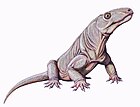
Therapsida is a major group of eupelycosaurian synapsids that includes mammals and their ancestors. Many of the traits today seen as unique to mammals had their origin within early therapsids, including limbs that were oriented more underneath the body, as opposed to the sprawling posture of many reptiles and salamanders. The earliest fossil attributed to Therapsida used to be Tetraceratops insignis from the Lower Permian. However in 2020, a new study has found that Tetraceratops is not actually a true Therapsid, but should be considered to be a member of the more ancient Sphenacodontia from which the therapsids evolved.

Dinocephalia is a clade of large-bodied early therapsids that flourished for a brief time in the Middle Permian between 270 and 260 million years ago (Ma), but became extinct, leaving no descendants. Dinocephalians included herbivorous, carnivorous, and omnivorous forms. Many species had thickened skulls with many knobs and bony projections. Dinocephalians were the first non-mammalian therapsids to be scientifically described and their fossils are known from Russia, China, Brazil, South Africa, Zimbabwe, and Tanzania.

Biarmosuchus is an extinct genus of biarmosuchian therapsids that lived around 267 mya during the Middle Permian period. Biarmosuchus was discovered in the Perm region of Russia. The first specimen was found in channel sandstone that was deposited by flood waters originating from the young Ural Mountains.

Eotitanosuchus is an extinct genus of biarmosuchian therapsids whose fossils were found in the town of Ochyor in Perm Krai, Russia. It lived about 267 million years ago. The only species is Eotitanosuchus olsoni.

Biarmosuchia is an extinct clade of non-mammalian synapsids from the Permian. Biarmosuchians are the most basal group of the therapsids. They were moderately-sized, lightly-built carnivores, intermediate in form between basal sphenacodont "pelycosaurs" and more advanced therapsids. Biarmosuchians were rare components of Permian ecosystems, and the majority of species belong to the clade Burnetiamorpha, which are characterized by elaborate cranial ornamentation.
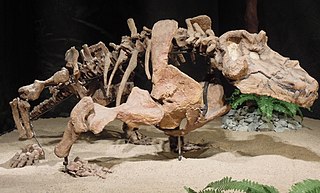
Estemmenosuchus is an extinct genus of large, early omnivorous therapsid. It is believed and interpreted to have lived during the middle part of the Middle Permian around 267 million years ago. The two species, E. uralensis and E. mirabilis, are characterised by distinctive horn-like structures, which were probably used for intra-specific display. Both species of Estemmenosuchus are from the Perm region of Russia. Two other estemmenosuchids, Anoplosuchus and Zopherosuchus, are now considered females of the species E. uralensis. There were many complete and incomplete skeletons found together.

Proburnetia is an extinct genus of biarmosuchian therapsids in the family Burnetiidae, from the Late Permian of Russia. It had bizarre bumps and protrusions on its skull.

Lemurosaurus is a genus of extinct biarmosuchian therapsids from the Late Permian of South Africa. The generic epithet Lemursaurus is a mix of Latin, lemures “ghosts, spirits”, and Greek, sauros, “lizard”. Lemurosaurus is easily identifiable by its prominent eye crests, and large eyes. The name Lemurosaurus pricei was coined by paleontologist Robert Broom in 1949, based on a single small crushed skull, measured at approximately 86 millimeters in length, found on the Dorsfontein farm in Graff-Reinet. To date, only two skulls of the Lemurosaurus have been discovered, so body size is unknown. The second larger, more intact, skull was found in 1974 by a team from the National Museum in Bloemfontein.

Burnetia is an extinct genus of biarmosuchian therapsids in the family Burnetiidae, from the Late Permian of South Africa. Burnetia is known so far from a single holotype skull lacking the lower jaws described by South African paleontologist Robert Broom in 1923. Due to erosion and dorsoventral crushing, features of the skull are hard to interpret. Stutural lines are further distorted by the unusual shape of the skull roof, including many bosses and protuberances.
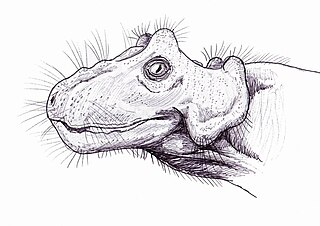
Paraburnetia is an extinct genus of biarmosuchian therapsids from the Late Permian of South Africa. It is known for its species P. sneeubergensis and belongs to the family Burnetiidae. Paraburnetia lived just before the Permian–Triassic mass extinction event.

Bullacephalus is an extinct genus of biarmosuchian therapsids belonging to the family Burnetiidae. The type species B. jacksoni was named in 2003. It is known from a relatively complete skull and lower jaw, discovered in the Late Permian Tapinocephalus Assemblage Zone of the Beaufort Group of South Africa.

Hipposaurus is an extinct genus of basal therapsids known from the Tapinocephalus Assemblage Zone of the Main Karoo Basin, South Africa. Chronologically this is within the Capitanian stage of the Guadalupian Series. The genus was first described by S.H. Haughton as H. boonstrai on the basis of a skull and associated skeleton and was later considered a gorgonopsian in the family 'Ictidorhinidae' by Robert Broom. It is now considered a basal biarmosuchian, but its affinities remain uncertain. H.boonstrai is currently known from only two specimens in the Iziko South African Museum, Cape Town.
Lycaenodon is an extinct genus of biarmosuchian therapsids from the Late Permian of South Africa. It is known from a single species, Lycaenodon longiceps, which was named by South African paleontologist Robert Broom in 1925. Both are small-bodied biarmosuchians. Two specimens are known, and both preserve only the front portions of the skull. These specimens come from the Cistecephalus Assemblage Zone of the Karoo Basin. Broom attributed the back portion of a third skull to Lycaenodon, but subsequent examiners considered it to belong to a gorgonopsian or dinocephalian and not a biarmosuchian. Most of the distinguishing features of Lycaenodon come from its palate. As a member of Biarmosuchia, the most basal group of therapsids, Lycaenodon shares many features with earlier and less mammal-like synapsids like Dimetrodon.

Raranimus is an extinct genus of therapsids of the Middle Permian. It was described in 2009 from a partial skull found in 1998 from the Dashankou locality of the Xidagou Formation, outcropping in the Qilian Mountains of Gansu, China. The genus is the most basal known member of the clade Therapsida, to which the later Mammalia belong.

Herpetoskylax is an extinct genus of biarmosuchians which existed in South Africa. The type species is Herpetoskylax hopsoni. It lived in the Late Permian Period.

Hipposauridae is an extinct family of biarmosuchian therapsids from the Late Permian of South Africa. It includes the genus Hipposaurus, and possibly the genera Hipposauroides and Pseudhipposaurus. A closely related biarmosuchian is Ictidorhinus, which has been placed in the family Ictidorhinidae.
Ustia is an extinct genus of biarmosuchian therapsids from the Middle Permian of Russia. It is known from a single species, Ustia atra, which was described in 2003 from an isolated lower jaw. Ustia was classified in the family Ictidorhinidae, which also includes the genus Ictidorhinus from South Africa. Both are relatively small biarmosuchians. Several other Russian therapsids known only from lower jaw bones have been placed in Ictidorhinidae, and the family is likely a paraphyletic assemblage representing a small body type than a true clade.
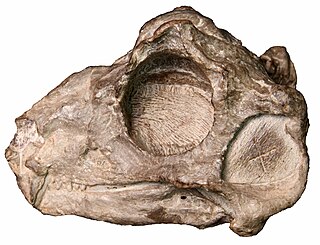
Lende is an extinct genus of biarmosuchian from Malawi. It contains one species, Lende chiweta, first reported by Jacobs and colleagues in 2005 and is a burnetiamorph – a group of biarmosuchians characterized by numerous bosses and swellings on the skull. The type specimen was discovered in the early 1990s in the Permian Lower Bone Bed (B1) of the Chiweta Beds of Malawi, which are believed to correlate with the Cistecephalus Assemblage Zone of the South African Karoo Supergroup, the Usili Formation of Tanzania, and the Upper Madumabisa Mudstone of Zambia. The holotype of the genus Lende is MAL 290, which comprises an almost complete skull and lower jaw.
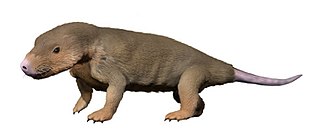
Abdalodon is an extinct genus of late Permian cynodonts, known by its only species A. diastematicus.Abdalodon together with the genus Charassognathus, form the clade Charassognathidae. This clade represents the earliest known cynodonts, and is the first known radiation of Permian cynodonts.
Leucocephalus is a genus of biarmosuchian belonging to the family Burnetiidae dating to the Wuchiapingian. It was found in the Tropidostoma Assemblage Zone (Tropidostoma) of the Main Karoo Basin of South Africa. It is a monotypic taxon which contains one only species, Leucocephalus wewersi. The genus name Leucocephalus is derived from Greek. Leucos, meaning white; kephalos, meaning skull, as the Leucocephalus skull discovered was unusually pale. Wewersi comes from the farm employee who found the skull, Klaus ‘Klaasie’ Wewers.




















